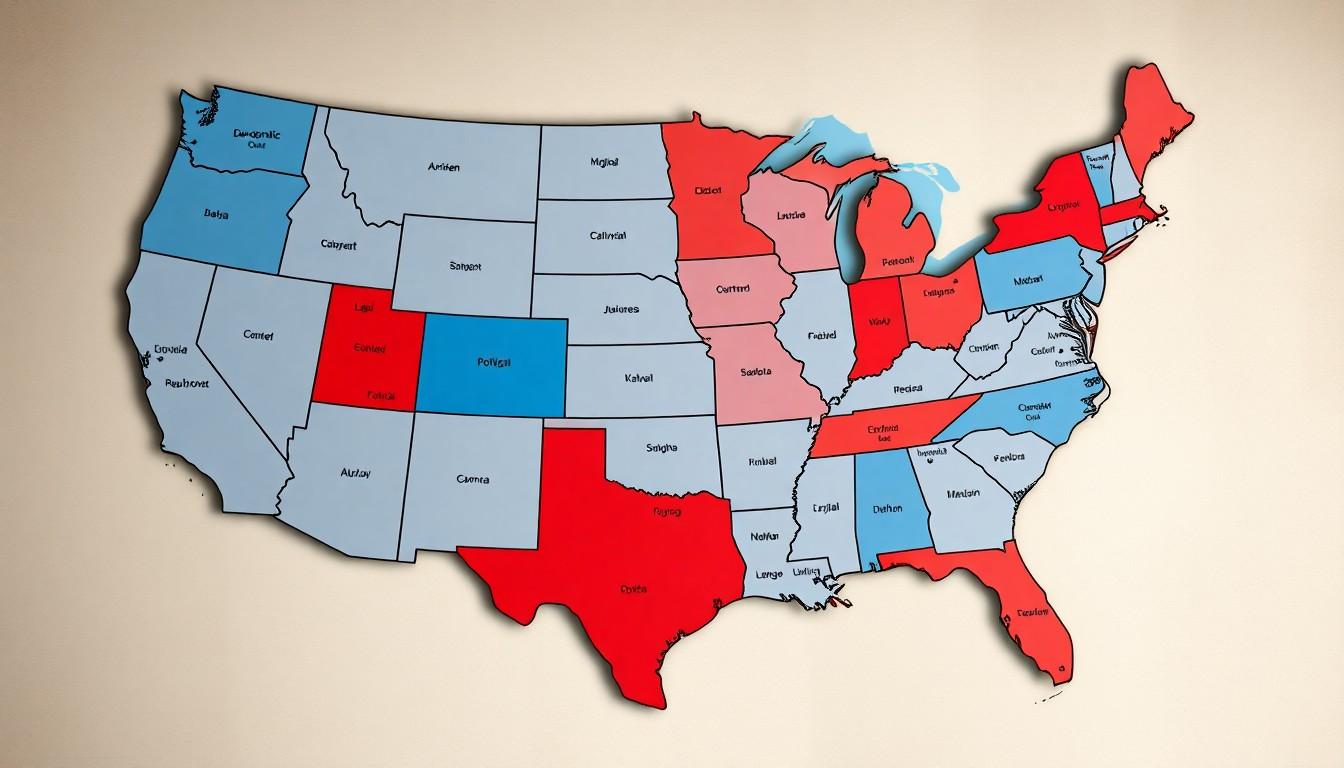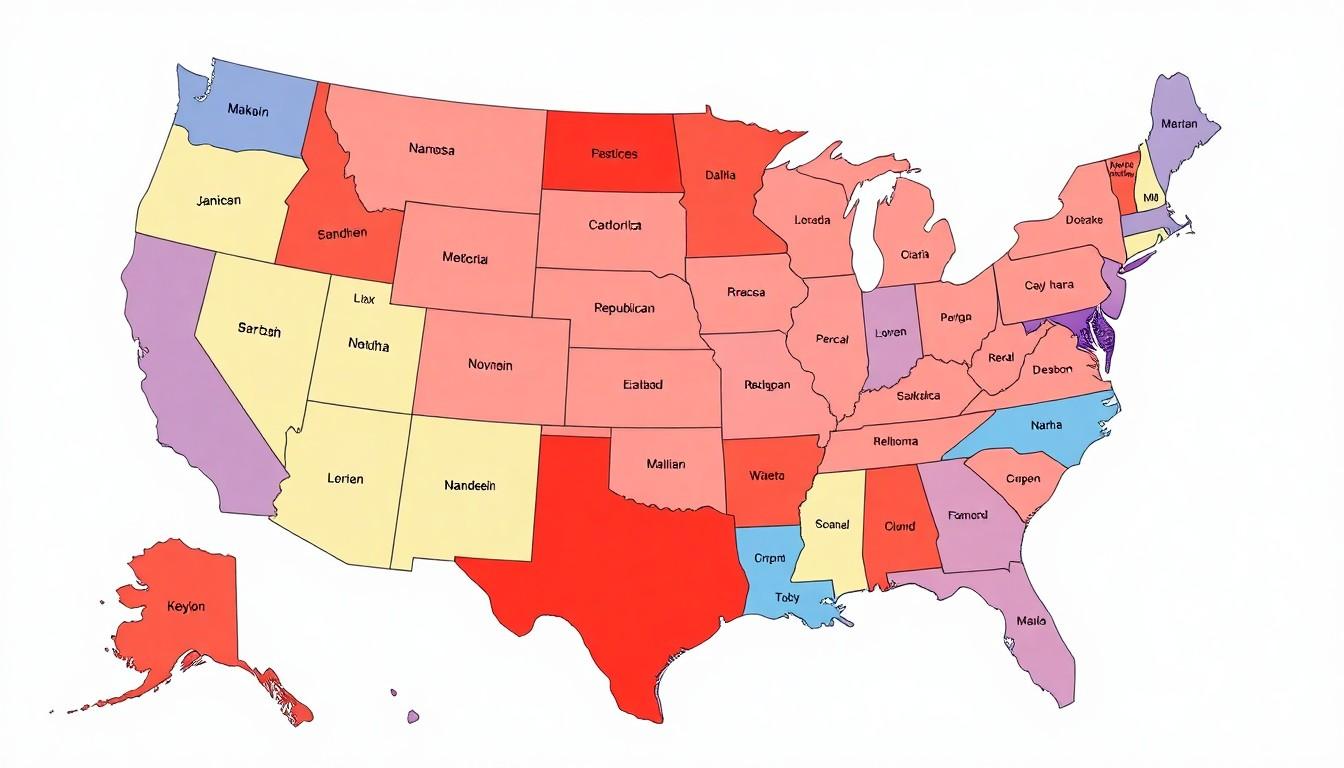Navigating the political landscape of America can feel like trying to find your way through a corn maze—confusing and full of surprises. With each state boasting its own quirks and ideologies, understanding the political map is crucial for anyone who wants to stay informed. Whether it’s the blue states, red states, or those perplexing purple ones, each color tells a story about the nation’s pulse.
In a world where political opinions can change faster than a chameleon on a rainbow, knowing where each state stands helps make sense of the chaos. So buckle up and get ready to explore the vibrant tapestry of American politics. It’s not just about maps; it’s about understanding the heart and soul of a nation, one colorful state at a time.
Overview Of The Political Map Of America
The political map of America visually represents the diverse political affiliations across the nation. States categorize as blue, red, or purple indicate their voting patterns in elections. Blue states lean Democratic, while red states favor Republican candidates. Purple states, also known as swing states, showcase significant electoral competition, often shifting between parties in different elections.
Each region of the country exhibits unique political characteristics shaped by demographics, economic factors, and historical contexts. For example, the West Coast tends to lean more Democratic due to urban populations and progressive policies. In contrast, the South traditionally supports Republican candidates, reflecting cultural and social values.
The Midwest presents a mix of both affiliations, with states like Illinois showing strong Democratic support, while states such as Iowa often swing between parties. The Northeast generally aligns with Democratic ideologies, driven by high population density and diverse communities.
District elections further illustrate the complexities within each state. Urban areas often display a Democratic majority, while rural regions typically lean Republican. Analyzing these districts helps reveal local issues affecting voters.
Understanding the political map of America is crucial for comprehending the nation’s broader electoral dynamics. As political trends evolve, shifts in state affiliations can impact federal policies and legislation. Knowledge of these trends allows citizens to engage more effectively in the democratic process.
Key Elements Of The Political Map

Understanding the key elements of the political map reveals the distinct geographic and demographic factors shaping American politics. Each component plays a critical role in dissecting the political landscape.
State Boundaries
State boundaries create a framework for political representation in the United States. These lines dictate electoral districts during local and federal elections, leading to varied political affiliations across regions. States like California and New York consistently lean Democratic, while Texas and Alabama predominantly support Republicans. Changing demographics influence these boundaries, as urban populations often favor progressive policies, contrasting with the conservative tendencies of rural areas. The impact of state boundaries extends beyond representation; they affect resource distribution, policy implementation, and national discourse.
Major Cities
Major cities serve as political hubs, reflecting diverse ideologies and voting patterns within their states. Cities like San Francisco and New York embody progressive values and consistently vote for Democratic candidates. Conversely, cities such as Nashville and Birmingham often align with Republican preferences. Urban centers tend to attract younger, more diverse populations that advocate for social change, creating a contrast with nearby rural regions. Political campaigns frequently target major cities due to their substantial electoral influence, making them critical battlegrounds in national elections. Their unique political climate contributes significantly to the overall landscape of American politics.
Historical Context
Understanding the historical context of America’s political map reveals the dynamic changes shaped by cultural, social, and political forces.
Evolution Of Political Maps
Political maps of America evolved significantly throughout history. In the early 19th century, boundaries reflected territorial expansions driven by events like the Louisiana Purchase in 1803. Many states emerged from the Northwest Ordinance of 1787, establishing patterns of settlement and governance. Over time, the Civil War in the 1860s further shaped political divisions, particularly in the South. Red and blue states represent trends that transitioned over decades, influenced by shifting demographics and urbanization. Modern digital maps illustrate these affiliations, adapting to real-time electoral results and ongoing census data.
Key Historical Events Impacting Boundaries
Several key events altered the political boundaries of America. The Treaty of Guadalupe Hidalgo in 1848 expanded U.S. territory significantly after the Mexican-American War, incorporating present-day states such as California and Texas. Major legislation like the Kansas-Nebraska Act of 1854 allowed for a determining factor in boundary changes based on popular sovereignty. The Voting Rights Act of 1965 strengthened representation in historically underrepresented areas, impacting the modern political landscape. Additionally, significant shifts in migration patterns in the late 20th century introduced new constituencies, further influencing state dynamics and political affiliations.
Current Political Landscape
The political landscape in America presents dynamic shifts influenced by diverse affiliations. Understanding these relationships clarifies the nation’s electoral dynamics.
Political Parties Representation
Political representation varies significantly across states. Democrats primarily dominate blue states, focusing on urban issues and social justice, while Republicans lead in red states, emphasizing traditional values and economic conservatism. Purple states often feature competitive races, reflecting diverse voter bases with mixed ideologies. This mixture tests party strength, showcasing the importance of grassroots campaigns and local issues that resonate with residents. Significant political groups advocate for various causes, influencing party platforms. Each party strategizes to appeal to shifting demographics, fostering engagement and participation within their constituencies.
Significant Electoral Votes
Electoral votes play a crucial role in presidential elections. States with higher populations, like California and Texas, hold more electoral votes, making them essential battlegrounds. With 55 electoral votes, California leads the nation, while Texas follows with 38. Swing states such as Florida and Ohio, which boast 29 and 18 electoral votes, often pivot the election outcome. Consequently, candidates prioritize these regions during campaigns to maximize their chances of securing the necessary majority. Understanding the distribution of electoral votes reveals how strategic campaigning can significantly alter election results, influencing the overall political landscape of America.
Tools And Resources For Analyzing The Map
Analyzing the political map of America requires effective tools and resources. Several options help users understand political affiliations and electoral dynamics.
Online Mapping Tools
Online mapping tools enable users to visualize political landscapes across the country. Websites like ArcGIS and Mapbox offer customizable maps that display various datasets. Users can layer political affiliations, demographics, and electoral results to see how geographic areas influence political trends. Google Maps also provides a platform for integrating data, making it accessible for broader analysis. Such tools facilitate a dynamic approach to studying the complexities of the political map.
Educational Resources
Educational resources provide valuable insights into understanding America’s political map. Websites such as the Pew Research Center and the Brookings Institution offer in-depth analysis regarding demographics, voting behavior, and shifts in political trends. Academic journals publish research discussing the historical and social factors influencing political affiliations. Online courses from platforms like Coursera cover essential topics in political science, enhancing comprehension of electoral systems. Utilizing these resources empowers individuals to gain a comprehensive understanding of the political landscape.
Conclusion
The political map of America serves as a vital tool for understanding the nation’s complex political landscape. It highlights the diverse affiliations that shape electoral dynamics and influence policy decisions. By examining the unique characteristics of each state and the historical context behind them, individuals can better engage with the democratic process.
As the political climate continues to evolve, staying informed about shifts in state affiliations and the impact of demographics is crucial. Utilizing available resources and tools can enhance one’s comprehension of these dynamics, fostering a more informed electorate capable of navigating the intricacies of American politics.

